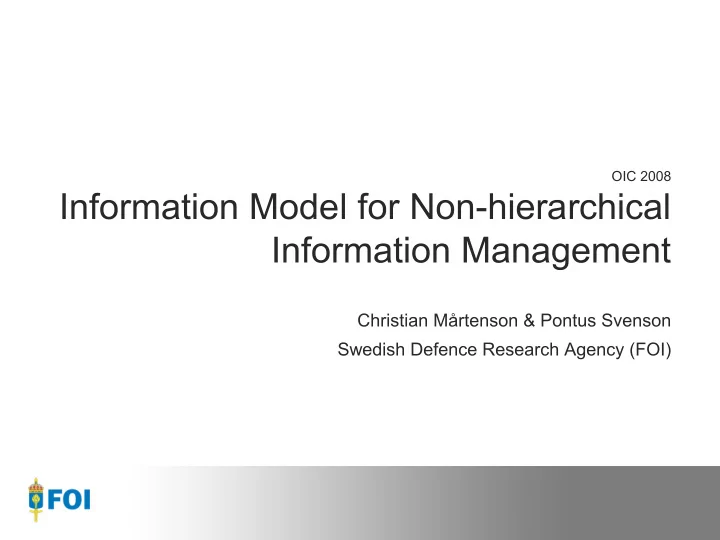

OIC 2008 Information Model for Non-hierarchical Information Management Christian Mårtenson & Pontus Svenson Swedish Defence Research Agency (FOI)
Outline Semantic technologies for information fusion The Semantic MilWiki Transformation distances Knowledge Support Non-hierarchical information management Observations
Semantic technologies for information fusion Information fusion deals with the combination and integration of data from different sources (sensors, human observers, databases, simulation) in order to help users achieve situation awareness. User involvement is a vital part of fusion Semantic techniques could be used to determine what information should be sent to which fusion algorithms [SPIE-paper, to appear]
Semantic MilWiki FOI plug-in to MediaWiki Semantic annotation JENA reasoner SPARQL-Wizard
Semantic MilWiki Combining structured and unstructured information Dynamic content Collaborative (semantic) editing
Layers of ontologies Shared ontology . In order to build systems of systems, a shared ontology can be applied to enable interoperability (JC3IEDM for C2-domain) Application model . Each application has a dedicated information model for optimal manipulation and storage of its data Application view model . The application interfaces are designed to serve user needs in an intuitive way. The representation of information in the interface defines an implicit ontology. User model . Each user of the system has its own mental model of the world and the system, depending on things like current task, role and cultural background.
Transformation distances Information between different ontology layers has to be transformed User User By transformation distance we Application views mean the degree of User Application Sensor models heterogeneity of two ontologies User Shared Ontology Long transformation distances Sensor increase risk for incompatibilities User
Ontology Designed for minimal transformation distances Close to both shared ontology and user model Based on JC3IEDM Added deeper hierachies for classes and relations Added inverses, transitivity, symmetry
Experiments Two ”explorative” workshops at the Joint C,D & E Centre (Swedish Armed Forces) Knowledge Support (KS) Non-hierarchical Information Management (NHIM)
Knowledge Support Developes new intelligence doctrine at operational level Uses systems analysis to produce knowledge Semantic MilWiki could feed the model with facts Dynamic queries catches new information and suggests model updates Example List all political persons that have been involved in an attack AND support the African Union
NHIM Improve decision-making using non-hierarchical information paths Faster but also more information Semantic queries used to select information to show to platoon commanders on an escort mission Example subscription All incoming reports on red activities along the planned route
Observation 1 Different approaches to ontolology construction In KS the analysts presumed knowledge needs were used as basis (top down, user-driven) In NHIM the intelligence reports formed the starting point (bottom up, data-driven) The approaches can (should) be used in combination
Observation 2 Conceptual mismatch between producers and consumers in NHIM (a transformational distance on user model level) Producers: Tagging of intelligence reports fairly straight-forward using objective tags (involved actors, type of event, location) Consumers: Formulating subscription queries fairly straight-forward using subjective tags (affects Attitude_to_blue_forces , Road_conditions or Fuel_availability)
Future work Investigate if context models (task, role, situation) can be used to translate subjective statements to objective Explore how the minimal transformation distance approach will hold when introducing fusion of uncertain statements Implement an information supply mechanism for information fusion systems based on semantic techniques Study how good relational extraction has to perform in order to be of value to an intelligence analyst
Questions… cmart@foi.se
Recommend
More recommend